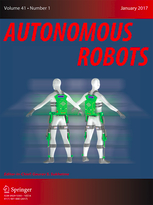~ Special Issue – Call for Papers ~
Topological Methods in Robotics

GUEST EDITORS:
Subhrajit Bhattacharya, Lehigh University ()
Florian T. Pokorny, KTH Royal Institute of Technology ()
Howie Choset, Carnegie Mellon University ()
Autonomous Robots invites papers for a special issue on Topological Methods in Robotics 🔗
SCOPE:
Over the past several years algebraic and differential topology have been used extensively in a variety of problems in robotics. Topological invariants have been used to reason about shapes of configuration spaces. Invariants have also been used to develop algorithms for computing optimal solutions in topologically distinct classes in configuration spaces, with direct application to multi-robot exploration problems, in systems involving flexible cables and robotic manipulators. Representation as simplicial complexes has transcended the traditional graph representations in context of sensor networks, making way for new methods in reasoning about the shape of configuration spaces and in developing effective coverage algorithms. With advances in persistent homology algorithms, topological data analysis techniques have been used on large data sets (such as 3D point clouds in context of visual mapping) and sensor networks for identification and classification of spaces based on their topology.
Topological methods in robotics is a new and emerging area of research. While it has already proven to have great potential in robotics and automation related applications, there remains a vast unexplored arena of open questions both in the fundamental and applied domains. Sensor coverage detection and coverage control using simplicial complex representations, the development of the field of topological motion planning for systems involving cables, robotic manipulators & in context of multi-robot exploration, and topological data analysis techniques on large data sets (such as 3D point clouds in context of visual mapping) and sensor networks for identification and classification of spaces based on their topology are but a few recent application areas with significant implications to the field of robotics and automation.
This special issue aims at presenting cutting-edge research in topological methods in robotic planning problems by bringing together a diverse set of high-quality research papers on the scientific foundations and the applications of topological methods in robot planning. We are soliciting contributions in the topics that include, but is not restricted to:
Topological path planning
Topological representation and abstraction of configuration spaces
Simplicial representations and homological methods in sensor networks
Topological data analysis and its application to robotics and automation
Topological complexity analysis of configuration spaces
Geometric and topological methods for machine learning and efficient non-standard representations
Topological representations for deformable object manipulation (knots and other representations)
Discrete geometry and its applications to motion planning, caging and configuration space analysis
IMPORTANT DATES:
Submission Deadline (extended): February 15, 2020
1st Round of Review: May 15, 2020.
Revised Submission Due: June 15, 2020.
Final Notification: August 15, 2020.

 PAPER
SUBMISSION:
PAPER
SUBMISSION:
Authors are encouraged to submit high-quality, original work that has neither appeared in, nor is under consideration by other journals.
Original and new research based on papers and posters presented at the ICRA 2016 workshop on “Emerging Topological Techniques in Robotics” or the ICRA 2019 workshop on “TopologicalMethods in Robot Planning” are welcome.
All papers will be reviewed following standard reviewing procedures for the Journal.
Papers must be prepared in accordance with the Journal guidelines: http://www.springer.com/10514
Submit manuscripts to: https://www.editorialmanager.com/auro/default.aspx
Select “S.I. 203: Topological Methods in Robotics” as article type when submitting.
Autonomous Robots http://www.springer.com/10514
Gaurav Sukhatme, Editor-in-Chief
Published by Springer.
short URL: